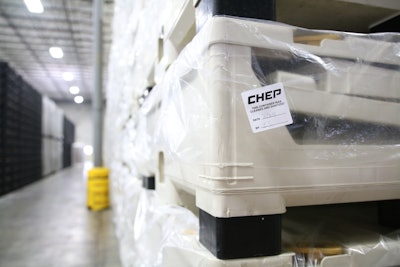
Supply chain leaders and food distribution partners must continually collaborate to improve their food safety practices, not only for greater consumer health protection but to also maintain food quality and meet the latest industry rules and regulations set by the U.S. Food and Drug Administration (FDA).
While there is no single source of risk for food safety, packaging is an integral part of the puzzle. It ensures ingredients are handled safely throughout the manufacturing process. Here are several best practices for optimizing packaging options for food and operational safety.
Navigating packaging choices to mitigate risk and maximize sustainability
Today, manufacturers have a wide range of packaging options for transporting food and beverage products. While this variety allows organizations to find the best solutions for their unique needs, it can also be challenging to identify the safest and most cost- and time-efficient options. To simplify this process, manufacturers can focus on the following packaging components.
Material. The first area for food manufacturers to consider is the packaging material and its pros and cons. For example, cardboard containers can be a cost-effective, lightweight option. But there is a downside—they can collect dust, mold and bacteria, negatively impacting the product itself, other cardboard packages during transport or even how transport professionals handle the boxes.
As a result, many manufacturers choose plastic alternatives. Plastic eliminates some of the safety concerns related to corrugate and can be a long-term, sustainable solution, especially in a pooled system.
Sanitation. When reviewing reusable packing options, hygiene and sanitation are key. Manufacturers often have to take on the extra work and responsibility to ensure containers are properly cleaned after every use. If done improperly, there’s a risk of cross-contamination.
To lighten this load, some pooled solutions providers handle the management and sanitization of reusable containers to meet all safety standards and regulations. This partnership lifts the burden off food manufacturers, letting them focus on what they do best.
Traceability. Another important area is traceability—not only for peace of mind, but compliance, too. The FDA’s Food Safety Modernization Act (FSMA 204) Traceability Rule from 2023 requires select products to track extra data as they move through the supply chain. Although enforcement was delayed by 30 months from its original January 2026 deadline, it’s smart for manufacturers to start preparing now by collaborating with supply chain partners.
Some leading vendors already provide individual container tracking, which can automate digital inventory records, batches and shipments to help food manufacturers comply with federal safety regulations. Plus, having this data is essential in the event of an audit or recall.
Environmental impact. The environmental impact of packaging should also be considered against an organization’s sustainability goals and best practices. While no option is perfect for transporting food and beverage ingredients, there are distinct benefits to leveraging reusable plastic containers over single-use corrugate packaging that requires disposal or resource-intensive recycling after every use.
Of course, many factors influence packaging sustainability beyond the material, such as overall transportation efficiency, resource recovery and product lifecycle. That's why some manufacturers are joining pooled programs to benefit from the cost and environmental savings of a circular system.
Optimizing operational safety through design
Another key part of the food safety discussion is how containers are stored and handled, which is just as important as the packaging itself.
Racking and stacking. Racking and stacking of goods can pose potential challenges and hazards that could impact warehouse worker safety. For example, setting up cardboard and strapping it to pallets may create ergonomic challenges and potential injuries from snapping straps. Manufacturers could consider alternatives like intermediate bulk containers (IBCs), which reduce manual handling and safety risks. One 315-gallon IBC ships the same volume as six drums and be set up by a single operator in less than a minute, compared to the 15 minutes and physical effort required for cardboard.
With plastic containers like drums, improper stacking can cause them to become unstable, creating a safety risk. A supply chain partner can collaborate with manufacturers to identify and mitigate these possible drawbacks, like using packaging with interlocking designs to support product stability during transport.
Durability and leaks. Further, durability can directly impact operational safety. As mentioned earlier, any moisture that cardboard or non-durable plastic containers encounter, whether from their own leakage or another container, can weaken their structure and make them unstable.
Leaning into partnership
Overall, safety isn’t a one-person or one-time job—it’s a constantly shared responsibility for the entire supply network. Collaborating with an experienced industry partner can provide manufacturers with expert insight on how best to leverage durable, traceable and sustainable packaging. Through this partnership, manufacturers can confidently meet today’s regulations while enabling safer outcomes across the supply network all the way to the end consumer.



















